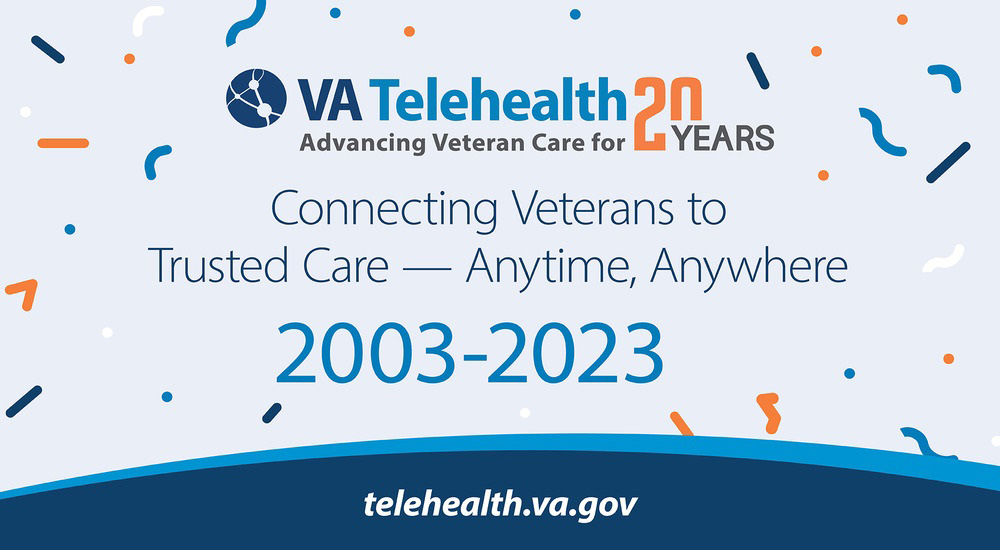This May will mark 20 years since the launch of the VA Telehealth Services program office. That’s 20 years of connecting Veterans to VA care from the comfort and convenience of their homes, and 20 years of innovating new technologies, breaking down barriers and expanding what’s possible.
And what does the future hold? Twenty years of moments like this one, from 2003, when nurse Rita Kobb signed in to a routine video telehealth visit with a Veteran who had high blood pressure. In the middle of that visit, through the computer screen, she noticed worrisome symptoms.
“His mouth started to droop, his eyelids started to droop and his speech became slurred,” Kobb said. “It was obvious to me he was having a stroke.”
The Veteran was home alone, so Kobb contacted emergency services to bring him to a VA medical center. He got there in time for providers to prevent permanent damage from the stroke. For years after, Kobb received letters and holiday cards from the Veteran and his family. “They were always thanking me and VA for everything that we had done for him.”
National program foundation began in 2003
It’s one of the countless stories about a program started by then-VA Under Secretary Robert Roswell in 2003. VA had technically been offering telehealth capabilities for years, but a successful pilot program in VISN 8 helped lay the foundation for a new national program. This new program established formal staff training and expanded clinical offerings to include remote patient monitoring.
“Home telehealth was so well received by Veterans,” said Kobb, one of the office’s original employees who is now the training and outreach lead. “They saw it as a way to access care in a way they never had been able to before. We even had patients referring other patients. They would sit in the waiting room in the clinics and would say, ‘Oh, I’m on this new program, this home telehealth program. You should really get on it. It’s great. They can do all this stuff for you.’”
And so it grew. And grew. In fiscal 2022, more than 2.3 million Veterans took part in over 11 million episodes of care through telehealth. And Veterans aren’t stopping at video visits. They’re also using VA apps to send their VA care teams their health data, such as their heart rate, glucose level and post-surgery photos. They are even taking part in virtual exercise programs.
3,000% increase in video visits during pandemic
The use of these services surged at the height of the COVID-19 pandemic. Over the past three years, the number of video visits to Veterans’ homes has increased by 3,000%. Along the way, the office has also offered training for non-VA providers dealing with skyrocketing demand for telehealth.
“We’ve grown to be the number one provider of telehealth in the United States, and one of the largest providers of it in the entire world,” Kobb said, when asked what she’s most proud of about this office’s journey. “People look to us from outside the agency as an expert and as somebody to model their programs after.”
What might the next 20 years hold?
“Our top priority is providing the best care for Veterans as soon as possible,” said Dr. Kevin Galpin, executive director of VA Telehealth Services. “That means delivering health care without walls and expanding access to high-quality VA care services even further.”
Pushing that momentum further, breaking down even more barriers, connecting more Veterans to VA care, the innovations keep coming to do just that.
“I couldn’t even begin to tell you where I think we’re going,” Kobb said. “We’re already farther ahead than I ever thought we would be at this point in the evolution of the program.”
To read more stories about VA Telehealth, visit VA News and Information. For more information, visit https://telehealth.va.gov/.
Topics in this story
More Stories
Study underscores important role COVID vaccination can have in protecting Veterans from infection and reducing long-term health consequences
Columbia VA’s robotic surgery teams completed their 800th robotic surgery and are on schedule to hit 1,000 by the end of the year.
In a decentralized clinical trial, Veterans can participate from their own homes or local VA instead of having to travel to a research site.






